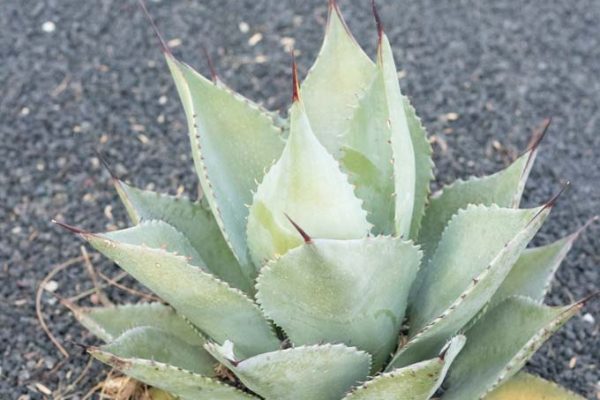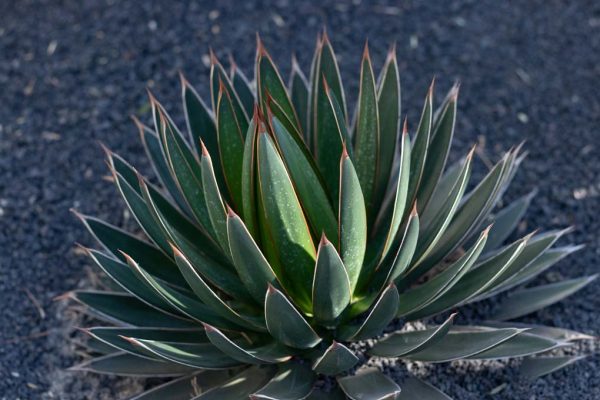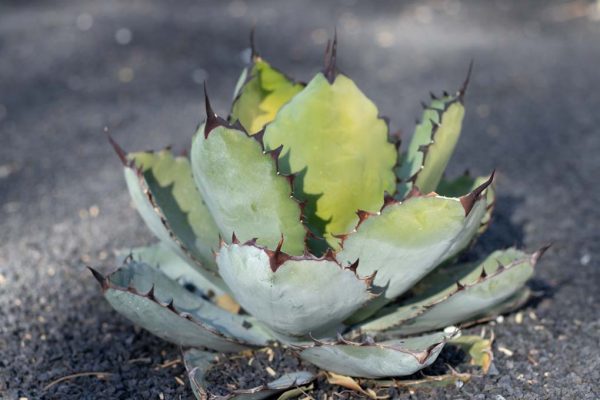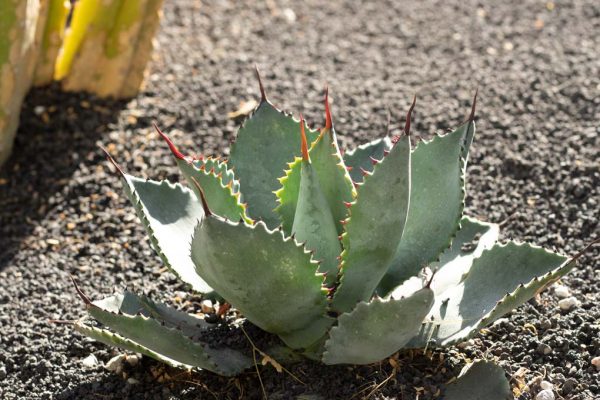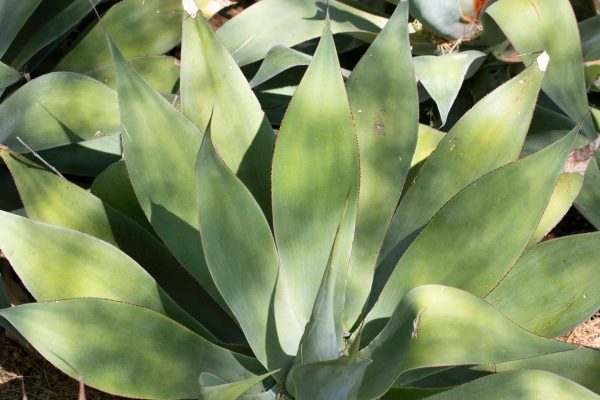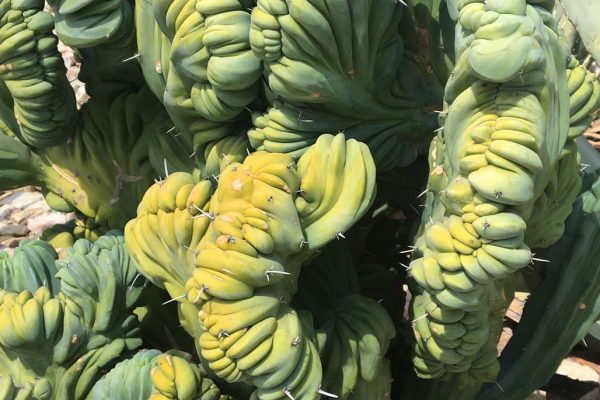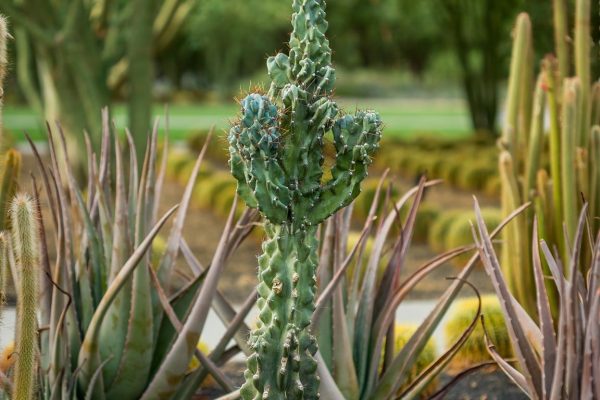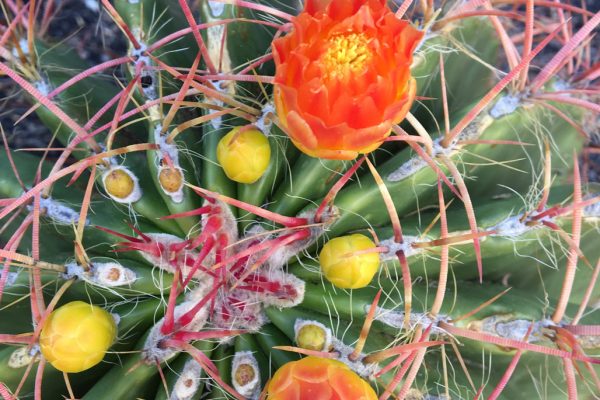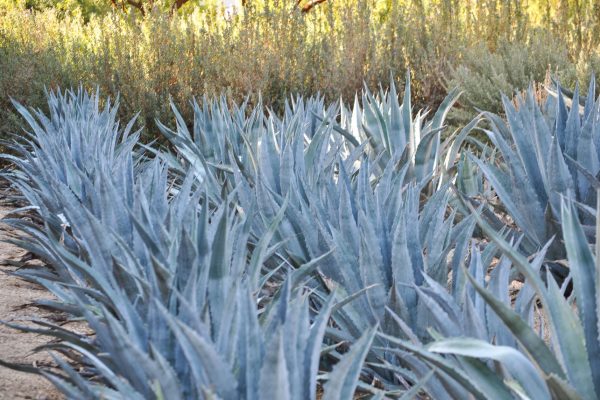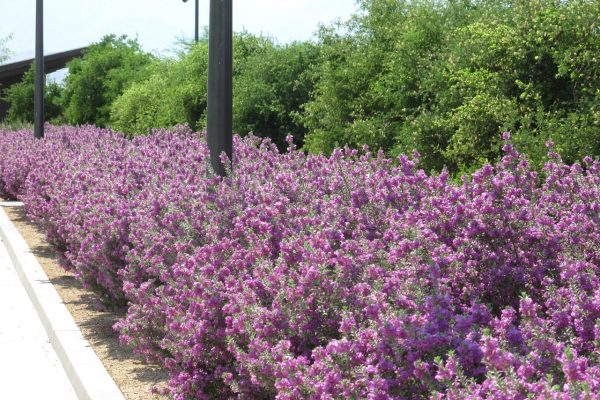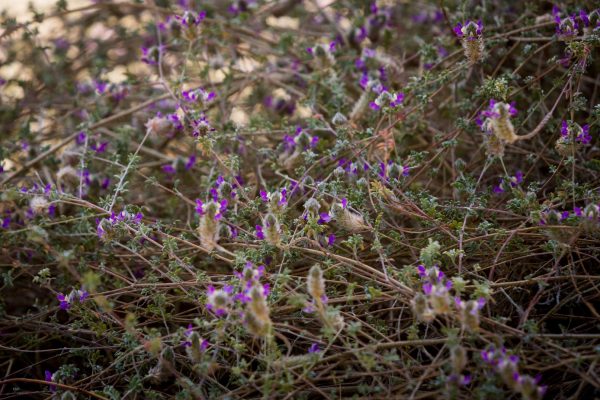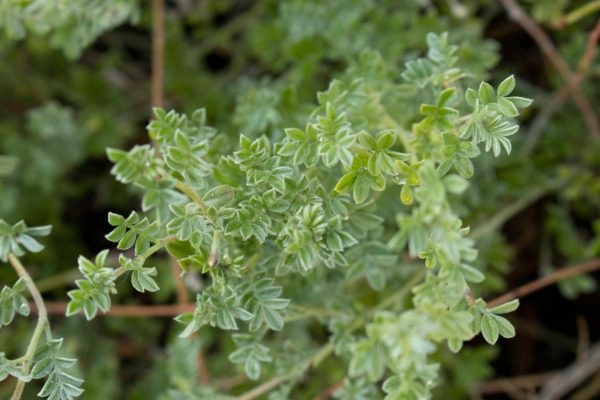This 2021 garden addition is planted in specimen beds nearest the solar fields. A medium agave, it grows up to 3 feet wide with pale green to gray leaves that curve cup-like towards the center. Curved teeth also line the black leaf margin and end in a long, black terminal spine.
These plants originate in the more temperate climates of the islands west of Baja, California, on West San Benito, Natividad and their namesake, Cedros Islands. They are also being cultivated from tissue cultures.
This hardy agave, which can stand temperatures down to 15°F, is in the specimen beds nearest the solar field. It can tolerate shade but prefers sun. With rosettes of straight narrow toothless leaves, growing 2 to 3 feet tall, it resembles a yucca. Like the yucca, it has been harvested for its leaf fibers, which gives it its name meaning fiber or cord.
It will grow an 8-foot tall stalk at its end of life with yellow blooms. Unlike other agaves, it does not form clones or offsets.
Native to Sonora, Mexico, this agave seems to prefer rocky slopes at an elevation between 1,500 and 4,500 feet.
This new variety has replaced the original Gentry’s Agave (Agave titanota) in the south-west corner of section 1 on the map. Smaller than the original Gentry’s Agave, this one can have blue-gray to green leaves and black teeth along its leaf margins.
It can grow to a height of 2 feet and spread up to 3 feet, and will produce clones, creating tightly packed colonies.
This titanota variety originated in Oaxaca, Mexico, and was grown by seed, but is now also being propagated in labs through tissue culturing. It’s not certain whether this plant qualifies as a cultivar or hybrid as several varieties of A. titanota are now being described as a new species of their own.
Added to the gardens in 2021, Pygmaea Agave is a new dwarf variety. It is dark green with flat leaves rarely exceeding 12 inches (30 cm) in length. It can be found in the far north specimen beds near the solar field.
Pygmaea prefers a limestone habitat. Its origins are in Mexico, Chiapas, and north of the Mexico-Guatemala border.
A slow grower, it does well in heat but is frost tender.
You may find it under the botanical name of Agave Pygmaea Gentry or Agave seemanniana subsp. Pygmaea, which is how it is listed on this site.

Fox-tail is found throughout the west side of the gardens in planters around the Great Lawn. It grows on a curving stem that can reach up to five feet with additional rosettes forming and rising around its base. This makes it a unique addition as it can add height to garden spaces. The leaves are very soft with smooth margins, though occasionally they may grow small, serrated teeth. They can grow in color ranges from pale green to blue-green.
The inflorescence (blooming stem) has a distinctive curve that grows up, and then bends down and then up again. The curving pattern is where it derives its name, as it resembles a foxtail. The blooms pack densely along the stem and bloom a pale green between December and January. Collection of seed and offsets are the most common cultivation method.
Distribution in Mexico is at higher rocky ranges around 6,000 feet. Fox-tail is considered rare outside of cultivation. There are few locations where it currently grows. According to Mary Irish, it was first described from cultivars grown in Europe that were collected in the 1850s from an unknown location in Mexico.
Care should be taken as Fox-tail can be lost to frost. On temperate coasts, it can do well in the sun, but not in the hotter desert regions where it may be too much.

Crested Blue Flame is in the north specimen bed nearest the Café and Solar Field. It’s easily identified by its shape, which is a series of heavily folded skin. It makes it eye-catching. This feature has resulted in a variety of common names including Dinosaur Back, as well as “Crested” followed by multiple descriptive names. All an attempt to capture this unique growth pattern.
The pattern could best described as clustering, since it grows a trunk-like center crest, and then sends up additional stems that will grow around each other, thus forming a cluster. It makes an interesting addition to any garden space as quite an attractive curiosity.
At Sunnylands, it elicits questions from visitors, including “What’s wrong with that cactus?” For those used to more recognizable patterns of barrel, columnar, and pad producing cactus, this one is a surprise.
It’s also a growth pattern we see in other ecosystems, like the coral reefs. The corals are colonies of organisms that act as one, but the cactus creates this visual effect as a single organism.
The blooms are small with radiating petals and greenish-white in color.
The Night Blooming Cereus has some variability in its growth. It mainly grows similar to a tree-form, having stems that curve upward resembling branches. At maturity it can reach as high as 35 feet. Spines may be completely absent or grow as long as two inches.
This cactus has bloomed at Sunnylands producing a large, beautiful white bloom, tipped in pinks and reds. The bloom is followed by a red fruit with white pulp.
Assumed to be native to Venezuela and the Caribbean, but due to wide cultivation and distribution, this is not confirmed.
Also: Cereus repandus (Anderson)
This vibrantly colored cactus can grow solitary or in groups with spines that range from yellow to bright red and may even be combined on one plant. The spines have distinct banding and a slight curve. In the gardens they can be found in the specimen beds at the shuttle gate and nearest the solar field.
Flowers are a bright yellow and red-orange blend, which are followed by yellow fruit at the crown.
Their distribution is throughout Northern Central Mexico in San Luis Potosí, Zacatecas, Durango, Nuevo León, Coahuila, and Tamaulipas.

The Century Plant, or americana, is the largest agave in the gardens. It’s variable in color, ranging from green to blue-gray, and some varieties displaying variegated leaves. This species is the iconic representation of the genus selected by botanist Carl Linnaeus. It can grow up to 10 feet. The long leaves can recurve dramatically, and leaf margins display brown teeth.
The name Century Plant refers to the monocarpic (one bloom) nature of the genus, where blooms occur only after several years, sometimes up to 30 years, though it may seem like a century for some to bloom.
The inflorescence (flowering stalk) can reach up to 26 feet with 15 to 35 branches on the upper third of the stem. The blooms are yellow and appear in summer. The bloom cycle is dependent on climate and in warmer regions may happen at around 10 years. In cooler climates, it may take up to 35 years to bloom. The plant will die after that bloom but has likely produced many clones around its base in the meantime.
Its distribution is uncertain but widespread.

Leucophyllum is the genus for a group of hardy desert shrubs. Most people know it from the common name Texas Ranger or Texas Sage, though it is not a Salvia. Years of commercial cultivation has created a variety of sizes and colors that guarantee a visual variation for almost every desert garden. It blooms in ranges of deep purple to violet and periwinkle, and its fuzzy leaves range from green to silver-gray. Even its size can vary from large shrubs, reaching 6 feet, to smaller compact shrubs.
Sunnylands initially installed six specimens of Leucophyllum spp., but over the years, there have been a few species that triumphed in the gardens. They were the most pest resistant and stood out in color and form. We have reduced the original six to three highlighted species. They are distributed throughout the gardens and can be identified by leaf and/or bloom. The three are, by common name: Green Cloud, Heavenly Cloud, and Sierra Bouquet. They are grouped together here under their genus Leucophyllum, so that their visual features are easy to compare when standing in the gardens.
GREEN CLOUD (Leucophyllum frutescens ‘Green Cloud’)
Green foliage with purple flowers
HEAVENLY CLOUD (Leucophyllum x. ‘Heavenly Cloud’)
Green foliage with bright purple flowers
SIERRA BOUQUET (Leucophyllum pruinosum ‘Sierra Bouquet’)
Gray foliage with periwinkle flowers

This member of the pea family is a shrub that spreads, forming low-mounding hedges with small, fuzzy, silver-green leaves. It’s a popular choice for ground cover in difficult locations like slopes or medians as it can handle full sun and reflected heat. Though its stems can get woody, it often grows back over those sections creating some cover habitat for wildlife. It requires well-drained soil.
Its blooms are small stalks with fuzzy, purple flowers.
Trailing Indigo Bush is native to Texas.
Tested for a couple years in the labyrinth, it was determined not to be a good fit and was replaced with the current Wedelia (Sphagneticola trilobata). It is still used around the wildflower field.
A LOOK ALIKE: At Sunnylands we have two similar species in the the Dalea genus. This offers a choice based on preference for bloom color of purple or yellow. This other species is known as Sierra Gold (Dalea capetata). It can be distinguished by its leaves, which are more of a bright green, and its yellow flower blooms.
Sierra Gold is a trailing groundcover planted along the entry drive and around the performance circle. It was not part of the original planting list, and was added a few years after opening in 2012.
LOOK ALIKE: It grows similarly to Trailing Indigo Bush, which was part of the original plant list installed prior to 2012. Both species are great choices for hot or reflected heat locations and slopes. The choice comes down to whether there is a preference for the true green and yellow flowers of Sierra Gold or the gray-green leaves and purple flowers of the Trailing Indigo Bush.
Native to Coahuila, Mexico.
